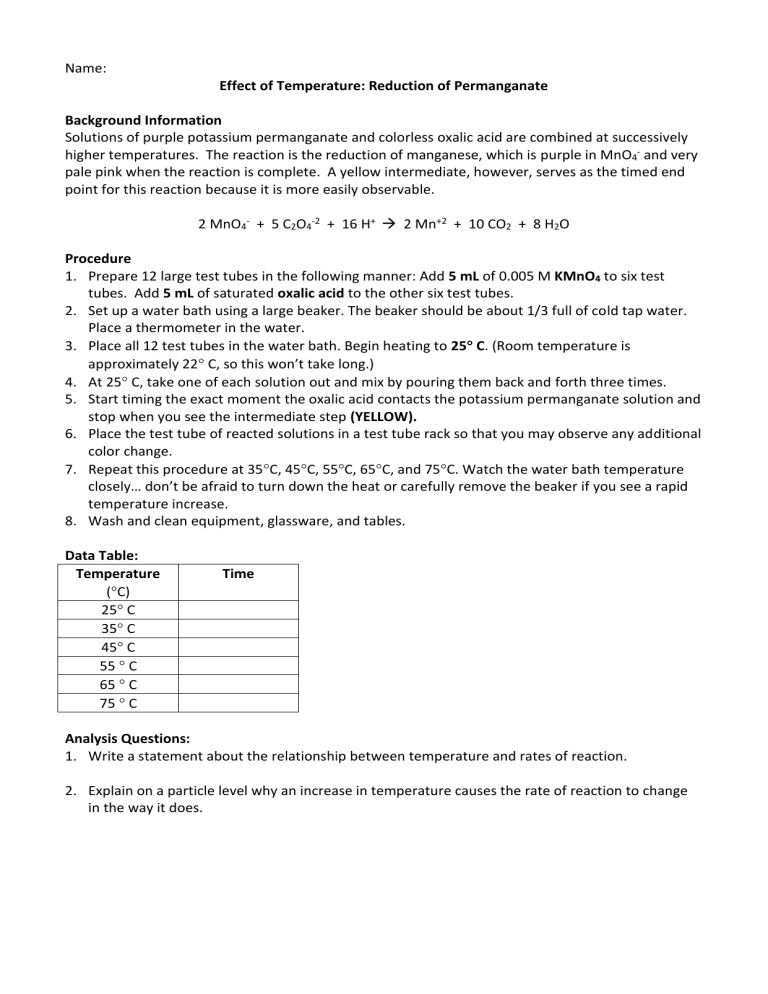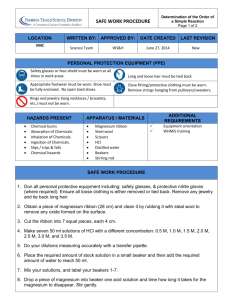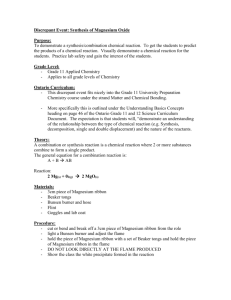Temperature, Concentration, Surface Area Reaction Rates Labs

Name:
Effect of Temperature: Reduction of Permanganate
Background Information
Solutions of purple potassium permanganate and colorless oxalic acid are combined at successively higher temperatures. The reaction is the reduction of manganese, which is purple in MnO
4
and very pale pink when the reaction is complete. A yellow intermediate, however, serves as the timed end point for this reaction because it is more easily observable.
2 MnO
4
+ 5 C
2
O
4
-2 + 16 H + 2 Mn +2 + 10 CO
2
+ 8 H
2
O
Procedure
1.
Prepare 12 large test tubes in the following manner: Add 5 mL of 0.005 M KMnO
4
to six test tubes. Add 5 mL of saturated oxalic acid to the other six test tubes.
2.
Set up a water bath using a large beaker. The beaker should be about 1/3 full of cold tap water.
Place a thermometer in the water.
3.
Place all 12 test tubes in the water bath. Begin heating to 25
C. (Room temperature is approximately 22
C, so this won’t take long.)
4.
At 25
C, take one of each solution out and mix by pouring them back and forth three times.
5.
Start timing the exact moment the oxalic acid contacts the potassium permanganate solution and stop when you see the intermediate step (YELLOW).
6.
Place the test tube of reacted solutions in a test tube rack so that you may observe any additional color change.
7.
Repeat this procedure at 35
C, 45
C, 55
C, 65
C, and 75
C. Watch the water bath temperature closely… don’t be afraid to turn down the heat or carefully remove the beaker if you see a rapid temperature increase.
8.
Wash and clean equipment, glassware, and tables.
Data Table:
Temperature
(
C)
25
C
35 C
45
C
55
C
65 C
75 C
Time
Analysis Questions:
1.
Write a statement about the relationship between temperature and rates of reaction.
2.
Explain on a particle level why an increase in temperature causes the rate of reaction to change in the way it does.
Effect of Concentration: The Starch-Iodine Clock Reaction
Background Information
Does changing the concentration alter the rate of a chemical reaction? If so...to what extent? In this experiment you will investigate the role of concentration by performing some experiments with an interesting reaction called the “clock reaction”. In order to determine the role of concentration on reaction rate, you will vary the concentration of one of the reacting species and keep other possible variables constant (including temperature).
The clock reaction is performed by mixing the two solutions described below:
Solution A is a starch solution (cloudy) and contains the hydrogen sulfite ion, HSO
3
.
Solution B is a dilute solution of potassium iodate, KIO
3
. This is the source of the iodate ion, IO
3
.
When the two solutions are thoroughly mixed, the ions of the resulting solution proceed through the following reactions:
1.
IO
3
+ 3 HSO
3
I + 3 SO
4
-2 + 3 H +
2.
5 I + 6 H + + IO
3
3 I
2
+ 3 H
2
O
3.
I
2
+ HSO
3
+ H
2
O 2 I + SO
4
-2
4.
I
2
+ starch color change
+ 3 H +
Only when the HSO
3
has been entirely consumed in reactions 1, 2, and 3 will the I
2
react with the starch in reaction 4. The occurrence of a color change indicates that all the HSO
3
has been consumed and I
2
remains in the solution.
Procedure
Prepare 10 test tubes in the following manner:
Solution A
Starch
(constant)
10.0 mL
Solution B
KIO
3
(diluting concentration)
10.0 mL
Time
10.0 mL
10.0 mL
10.0 mL
10.0 mL
8.0 mL of Soln B
2.0 mL of distilled H
2
O
6.0 mL of Soln B
4.0 mL of distilled H
2
O
4.0 mL of Soln B
6.0 mL of distilled H
2
O
2.0 mL of Soln B
8.0 mL of distilled H
2
O
1.
Using a stop watch, start the time to the nearest second as you pour solution A into Solution B.
Pour them back and forth quickly three times to insure uniform mixing.
2.
Stop timing when you see the color change occur.
3.
Repeat this procedure 4 more times with the varying concentrations.
4.
Wash and clean equipment, glassware, and tables.
Analysis Questions:
1.
Write a statement about the relationship between concentration and rates of reaction.
2.
Explain on a particle level why an increase in concentration causes the rate of reaction to change in the way it does.
Effect of Surface Area: Production of Hydrogen Gas
Background Information
Magnesium metal reacts with hydrochloric acid according to this reaction:
Mg (s) + 2HCl (aq) MgCl
2
(aq) + H
2
(g)
The rate of reaction can be found by either measuring the amount of reactant used up over a period of time, or the amount of product produced over a period of time. In this reaction, hydrogen is the easiest substance to measure. In this lab, however, we will only be making qualitative observations of the rate of the reaction, rather than collecting quantitative (numerical) data.
Magnesium powder has a greater surface area than magnesium ribbon.
Procedure
1.
Put 5mL of 1M HCl (hydrochloric acid) into two large test tubes.
2.
Obtain a small piece of magnesium ribbon. Take its mass using a weighing boat on a scale.
Record this mass. Remove the ribbon from the weighing boat and set it aside.
3.
Using a spatula, add small amounts of magnesium powder to the weighing boat until the mass of the magnesium powder is approximately the same as was the mass of the magnesium ribbon.
4.
Simultaneously, add the magnesium ribbon to one test tube and the magnesium powder to the other test tube.
5.
Record your observations of the quantity and duration of bubbles produced in the reaction.
6.
Wash and clean equipment, glassware, and tables.
Data Table:
Magnesium Ribbon Magnesium Powder
Approximate Mass (g)
Approximate quantity of bubbles produced
Approximate duration of time during which bubbles were produced
Analysis Questions:
1.
Write a statement about the relationship between surface area and rates of reaction.
2.
Explain on a particle level why an increase in surface area causes the rate of reaction to change in the way it does.






